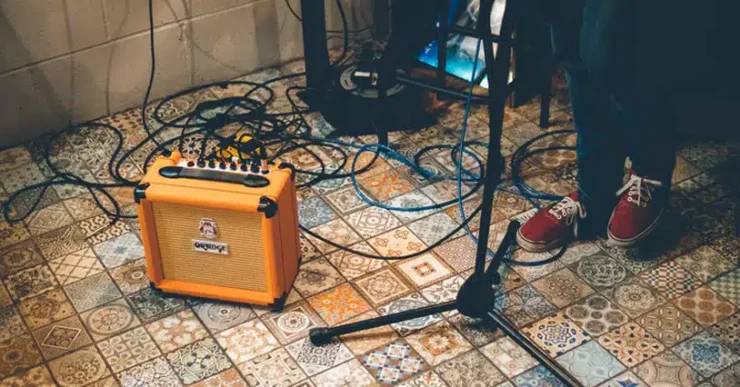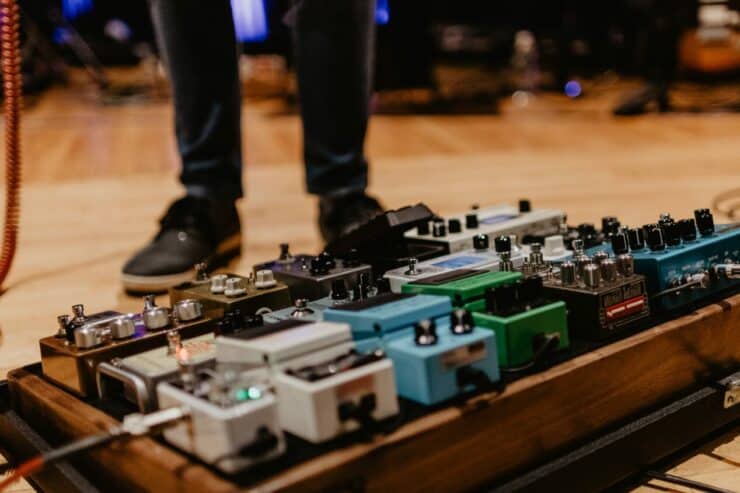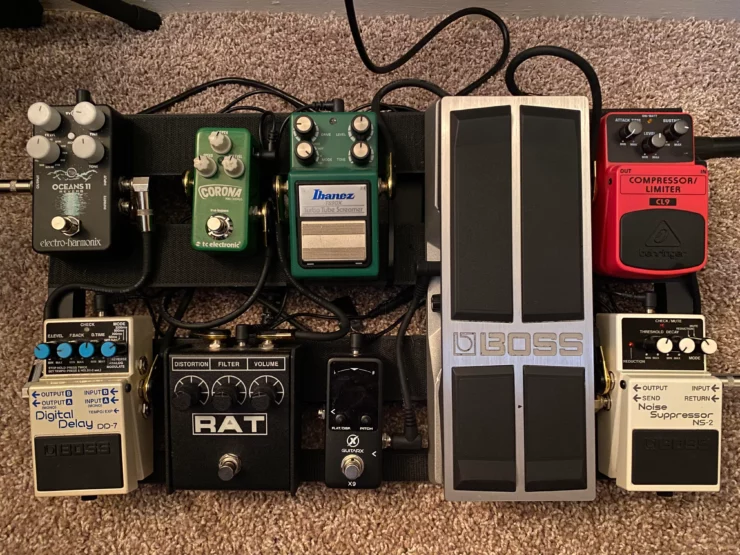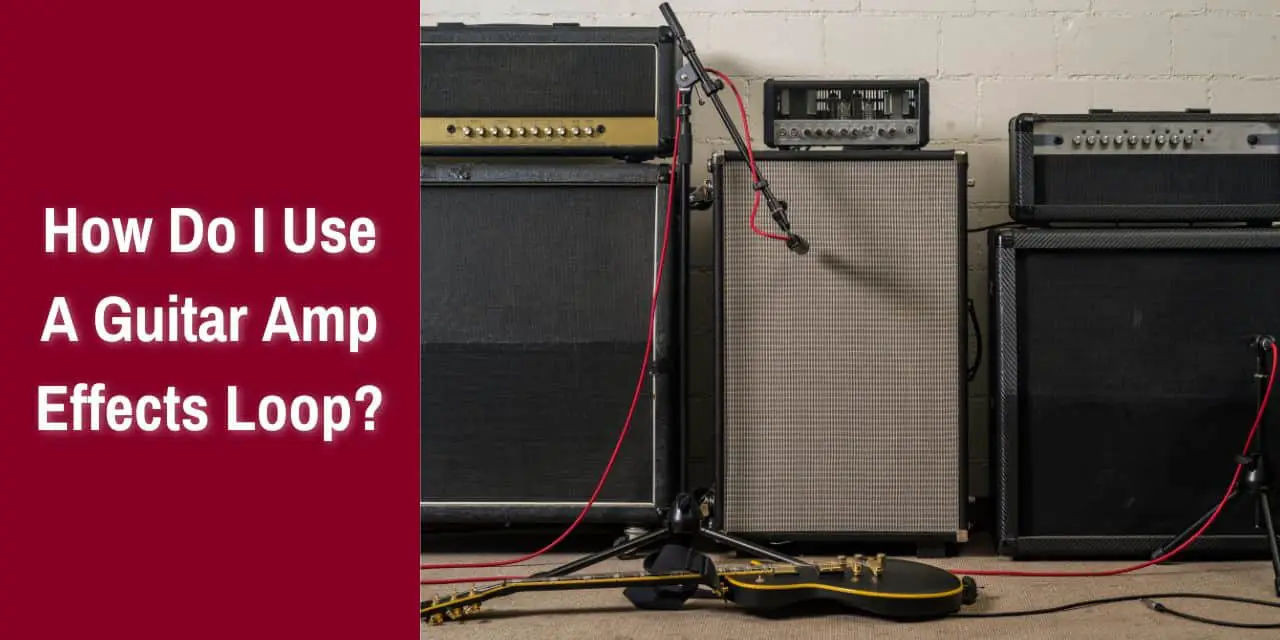Guitar players, are you looking to try something new with your music? Have you ever heard the term “effects loop” and wondered what it was? If you’re curious to learn more about how to use a guitar amp effects loop to enhance your sound, then read on! In this article, we’ll explain the basics of a guitar amp effects loop and how you can use it to take your playing to the next level.
What is an effects loop?
For musicians and guitarists, creating the perfect tone and exploring various sound possibilities is a never-ending quest. One important component in achieving a desired sound is the effects loop. Whether you are a beginner or a seasoned veteran, understanding what an effects loop is and how it works can greatly enhance your guitar setup.
An effects loop is a routing system sound on guitar amplifiers and some effects pedals that allow you to connect external effects processors or pedals within the amp’s signal chain. It provides a way to add modulation, time-based effects (like delay and reverb), and other pedals and the preamp section and before the power amp section of the amp.
How does an effects loop work?
To properly understand how an effects loop functions, it is important to have a basic understanding of a guitar amp’s signal chain. Typically, the signal chain consists of three main stages – the preamp, the power amp, and the speaker.
>>> Click here to read our review about the Top 15 Best Guitar Amps <<<
The preamp stage of an amp shapes the guitar’s raw signal, adding gain, equalization, and other tonal adjustments. It prepares the signal for amplification and sends it to the power amp stage. The power amp section amplifies the preamp’s signal to a level suitable for driving the speaker. It adds presence and volume and controls the overall output level. Meanwhile, the speaker converts the amplified electrical signal into audible sound.
How do the effects loops fit into the signal chain?
The effects loop begins with a “send” jack or “preamp out” located on the back panel of the amp. This sends a line-level signal from the preamp stage to the external effects. The line-level signal from the send jack is connected to the input of the external effects units or pedals. This will allow you to add modulation, time-based effects, or any other desired effects to the signal.
After passing through the external effects, the signal is then connected to the “return” jack or “power amp in” on the amp. This allows the processed signal to bypass the preamp stage and enter directly into the power amp stage.
The signal will now go through the power amp stage, where it is amplified and then sent to the speaker, producing the final sound.

Benefits of using an effects loop in your guitar setup
As a musician or guitarist, you are constantly looking for ways to enhance your sound and explore new sonic possibilities. One valuable tool at your disposal will be the effects loop found on many guitar amps. Understanding the benefits of using an effects loop can significantly elevate your playing experience and open up a world of creative opportunities. Here are the benefits of incorporating an effects loop into your guitar setup.
#1. Preserve signal integrity
One of the major benefits of using an effects loop is its ability to preserve the integrity of your guitar’s original signal. By connecting time-based effects (such as delay, reverb, or modulation) in the effects loop, you ensure that these effects are applied after the preamp section of your amp.
This prevents the preamp’s tone-shaping capabilities from being altered by the effects, allowing your guitar’s natural tone to shine through. This way, you will be able to maintain clarity and articulation while adding rich and atmospheric effects to your sound.
#2. Noise reduction
Placing noise-generating pedals like high-gain distortions or compressors in the effects loop can help minimize unwanted noise and interference. The effects loop allows these pedals to interact with the already amplified signal, reducing the chances of introducing additional noise into your signal chain.
This is especially beneficial when using high-gain settings or when stacking multiple gain-based pedals. By isolating these noisy effects in the effects loop, you’ll be able to enjoy a cleaner and more focused tone.
#3. Flexibility in signal routing
Using an effects loop offers greater flexibility in the routing of your effects pedals. You have the freedom to experiment with different pedal combinations and their order within the signal chain. Placing pedals in the effects loop allows you to control when and how their effects are applied to your signal.
For instance, you can place time-based effects after your preamp for a more spacious and ambient sound or position modulation effects in the loop for a unique and dynamic modulation experience. This flexibility empowers you to sculpt your tone according to your creative vision.
#4. Versatility in mixing wet/dry signals
An effects loop will allow you to mix wet (effected) and dry (unaffected) signals, providing further tonal possibilities. By blending the affected and unaffected signals, you’ll be able to create a balance between the original guitar tone and the desired effect. This is especially useful for effects like reverb and delay, where you can control the level of ambiance without compromising the clarity of your playing. Mixing wet and dry signals can add depth, dimension, and texture to your sound, giving you a greater sonic palette to work with.
How do I use a greater amp effects loop?
The effects loop in your guitar amp is a powerful tool that can shape your tone and unlock new sonic dimensions. Understanding how to adjust the levels and utilize the effects loop for specific sounds opens up an entirely new world of creative possibilities. Here is the answer to how do I use a guitar amp effects loop and get the perfect sound.

Adjusting levels for optimal tonal balance
The effects loop allows you to control the levels of your effects in relation to your dry (unaffected) signal. Properly balancing these levels is important for achieving a cohesive and well-rounded tone. You can adjust the levels in your effects loop using the send level and return level controls.
The send level control, usually found on the back panel of your amp, adjusts the strength of the signal sent to the effects loop. Increasing the send level will result in a hotter signal, which can help drive certain effects pedals more effectively. However, you should be cautious not to overload the input of your effects pedals as it can result in unwanted distortion or clipping.
The return level control determines the volume of the affected signal that comes back into the amp’s power amp section. Adjusting the return level will allow you to control the intensity of your effects in the overall mix. Be mindful of balancing the return level for maintaining clarity and avoid overwhelming your dry signal.
Experimentation will be important when adjusting the levels in the effects loop. Start off with conservative settings and make incremental changes until you achieve the desired tonal balance. Remember that the right balance will depend on your specific gear, playing style, and the desired effect.
Use the effects loop for specific sounds
The effects loop offers an impressive range of possibilities for achieving specific sounds and creative textures. You can use time-based effects, parallel processing, external effects processors, and more.
Playing delay, reverb, or modulation pedals in the effects loop can yield unique and spacious sounds. By applying these effects after the preamp stage, you’ll be able to maintain the clarity of your dry signal while adding lush ambiance or modulated textures to your sound. Experiment with different effect combinations and adjust the levels to find your desired balance between the affected and unaffected signals.
The effects loop will allow for parallel processing, where you’ll be able to split your signal and send it through separate effects paths. This technique involves using a Y-cable or a dedicated parallel effects blender pedal. With parallel processing, you’ll be able to apply different effects to different parts of your signal, creating complex and rich sonic landscapes. For instance, you can have a distorted signal running through one path and a clean, chorused signal running through another path, blending them together for a unique tonal blend.
The effects loop also accommodates rack-mounted effects processors or multi-effects units. These devices offer an impressive range of effects and sound-sculpting capabilities. By integrating them into your effects loop, you’ll be able to explore intricate signal routing options, precise effect control, and seamless integration with your amp’s preamp and power amp sections.
Different types of effects loops
When it comes to harnessing the power of effects pedals and shaping your guitar tone, understanding the different types of effects loops is important. There are a few popular configurations that offer distinct advantages and tonal possibilities. Here are the different types of effects loops and their unique characteristics.
Series effects loop
The series effects loop is the most commonly found effects loop configuration in guitar amps. It offers a sequential signal flow where the entire signal passes through each effect in the loop. In a series effects loop, the send jack will send the preamp signal to the effects pedals or processors whereas the return jack receives the processed signal back into the amp.
This signal flows from the preamp stage to the send jack where it is sent to the effects pedals. After passing through the effects, the signal will return to the return jack and continues to the power amp stage for amplification and eventual output to the speakers.
The series effects loop offers simplicity and ease of use. It’ll allow you to apply effects in a straightforward manner, with each effect in the loop affecting the entire signal. This configuration is well-suited for modulation, time-based effects, and other pedals that you want to apply to your entire signal chain.

Parallel effects loop
The parallel effects loop, also known as an insert effects loop, takes a different approach by allowing for parallel processing of the guitar signal. It splits the signal into two paths, one for the dry (unaffected) signal and the other for the wet (affected) signal. Similar to the series effects loop, the send jack will send the preamp signal to the effects pedals. However, instead of returning the processed signal to the return jack, it is first split into two paths – the unaffected path and the affected path.
The unaffected path, carrying the dry signal, bypasses the effects pedals and rejoins the affected path at the return jack. The affected path, carrying the processed signal, passes through the effects pedals and then merges with the unaffected path at the return jack. The merged signal will then continue to the power amp stage for amplification.
The parallel effects loop offers greater control over the blend between the dry and affected signals. It allows for more precise manipulation of the level and intensity of the effects. This configuration is perfect for achieving complex and nuanced sounds, such as blending distorted and clean tones or blending different effects together.
Choose the right effects loop for your needs
The choice between a series effects loop and parallel effects loop depends on your desired sound, playing style, and the effects pedal you intend to use. You need to consider a number of factors when making a decision like the desired effect placement, effect combinations, pedal compatibility, and more.
If you want to apply modulation, time-based effects, or other pedals to your entire signal chain, a series effects loop will be the straightforward choice. However, if you prefer more precise control over the blend of your dry and effected signals, a parallel effects loop offers greater flexibility.
If you’re planning to stack multiple effects pedals or experiment with complex signal routing, a parallel effects loop might be better at accommodating your needs. It’ll allow for seamless integration of different effects paths and offers endless possibilities for sonic exploration.
Some effects pedals are designed specifically for series effects loops whereas others work better in parallel configurations. Consider the compatibility of your effects pedals and how they’ll interact with each type of effects loop.
Tips or using an effects loop
An effects loop is a powerful tool that opens up a world of sonic possibilities for musicians and guitarists. By experimenting with different settings and combining effects in your effects loop, you’ll be able to create unique and captivating sounds that elevate your playing to new heights. Here are a few valuable tips to help you unlock your creativity and make the most of your effects loop.
#1. Know your gear and have a solid foundation.
Before you dive into the world of effects loops, it’ll be important to have a good understanding of your equipment. Take time to familiarize yourself with the basics like amplifier features, pedal compatibility, and more.
Study your amp’s manual to properly understand the specifics of your effects loop. Know the location of the send and return jacks and any control knobs associated with the effects loop, such as send level or mix controls.
Arrange your effects pedals in the effects loop according to your desired workflow. Time-based effects like delay and reverb generally work best after the preamp. Meanwhile, modulation and compression pedals can be placed before or after the preamp, depending on your preference.
Some effects pedals work better in the effects loop whereas others are more suited for the front end of the amp. Experiment with different pedals to determine which ones get the best results in your effects pedal.
After that, you should set levels. Start off with conservative send and return levels and make incremental adjustments to achieve the desired balance between your dry and affected signals. Avoid overwhelming your dry signal or losing clarity in the mix.
#2. Proper signal chain placement
When using an effects loop, it’ll be important to understand the ideal placement of your effects pedals within the signal chain. You need to place modulation effects like chorus, flanger, and reverb, as well as time-based effects like reverb and delay, in the effects loop. This will allow for a more spacious and ambient sound, as these effects can be applied to the amplified signal after it has passed through the preamp stage.
Distortion, overdrive, and fuzz pedals are typically placed in front of the amp’s input rather than in the effects loop. These pedals interact directly with the guitar’s signal before it reaches the preamp, allowing them to shape the core tone of your instrument.
#3. Experiment with settings
Once you set up the effects loop, it will be time to unleash your creativity and experiment with different settings. You will need to make the changes keeping factors like the order of effects and blending of wet and dry signals in mind.
Try to alter the order of effects within the effects loop. Place a modulation pedal before a distortion pedal as it can yield unique and unconventional tones. Experiment with different pedal combinations to discover new textures and sonic landscapes.
Adjust the levels of your affected and dry signals to achieve the perfect balance. Mixing wet (effected) and dry (unaffected) signals will add depth and dimension to your sound. Explore different blends for creating unique sonic textures.
Combine different effects within the effects loop to create layered sounds. For instance, adding a subtle reverb or delay to your distortion pedal can enhance sustain and create a more expensive sound. You shouldn’t be afraid to experiment with various combinations to find your signature tone.
#4. Embrace unconventional approaches
To push the boundaries of your effects loop, you should consider some unconventional approaches. Utilize a feedback loop by placing a reverb or delay pedal in the effects loop and routing the output back into the input. This can create ethereal, swirling sounds and infinite sustain. Experiment with different delay times and feedback levels for finding the sweet spot.
Incorporate a parallel effects loop to split your signal and process it separately. This will allow for unique combinations of effects and precise control over blending dry and affected signals. Try blending distorted and clean tones or experimenting with different modulation and time-based effects in parallel paths.
Explore the possibilities of rack-mounted effects processors or multi-effects units within your effects loop. These devices offer a vast array of effects and sound-sculpting capabilities. Integrate them into your setup to further expand your sonic palette.
FAQs
What is a guitar amp effects loop?
A guitar amp effects loop is a feature found on some amplifiers that allows guitarists to connect external effects pedals between the preamp and power amp sections of the amplifier. This allows the guitarist to have greater control over their sound and the effects they are using.
How do I connect my effects pedals to the amp’s effects loop?
To connect your effects pedals to the amp’s effects loop, you will need to use a series of patch cables between the effects pedals and the send and return jacks on the amp. The send jack connects to the output of the effects pedals, while the return jack connects to the input of the effects pedals.
What are the benefits of using an effects loop?
Using an effects loop has several benefits, including increased flexibility and control, improved sound quality, and the ability to switch effects on and off without affecting the tone of the amp. It also allows the guitarist to place their effects pedals in the optimal position within their signal chain, allowing them to achieve a more refined sound.



